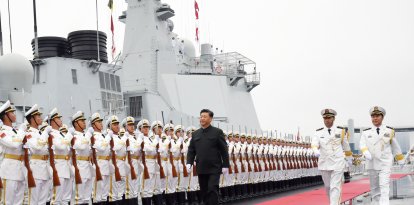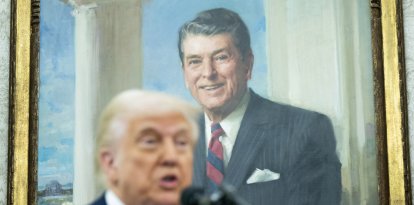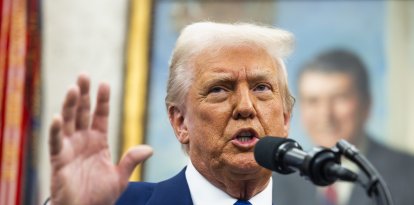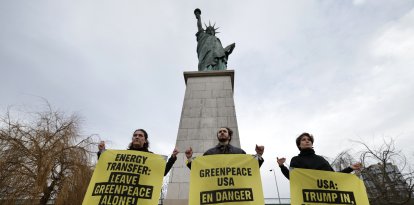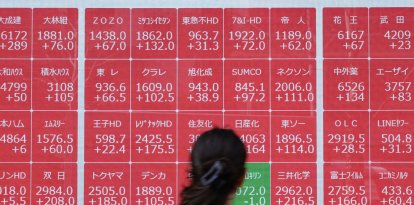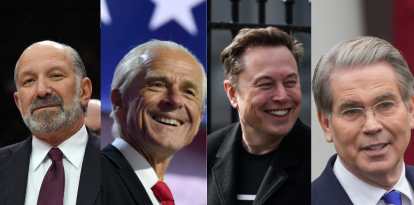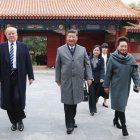China is winning on all fronts, its victory is just around the corner
Xi Jinping is pursuing an aggressive policy of sabotage, data control, and the colonization of culture and intelligence, while setting himself up as the star of multilateral meetings and taking advantage of global incompetence to expand his economic and political dominance on land and in the air.
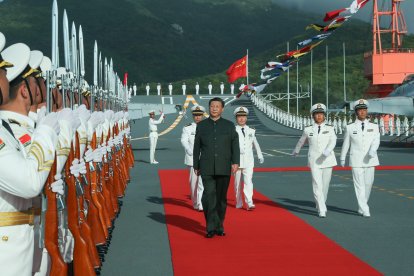
Xi Jinping boards Shandong aircraft carrier.
Whether we're talking about logistics, infrastructure, shipbuilding, communications, wind power generation, solar power generation, electric power generation, manufacturing, mineral processing or supply chain control, China is winning the race on all fronts. In 2021, China became Latin America's largest trading partner, surpassing the United States. Since, China set its eyes on the region where it has achieved dominance at the expense of the United States. Its latest achievement is the Chancay megaport in Peru, a deep-water port built entirely by China that cost up to $3.6 billion and will strengthen its geostrategic control.
Twenty-one countries in the region have signed the Belt and Road Initiative (BRI), an international cooperation strategy promoted in 2013 by Xi Jinping, who named it at first as the Silk Road Economic Belt. A little more than a decade later, China's relations with Argentina, Brazil, Venezuela, Chile, Ecuador, Peru and Mexico are at their highest level in history. Agreements abound based on the import of strategic raw materials such as copper, lithium, soybean oil and petroleum, while exporting manufactured goods. The new Chancay megaport will generate $4.5 billion a year for Peru, which, during its construction, was forced to change local legislation so that China would have exclusive rights. The port will save shipping costs for several Latin American countries by eliminating transit through the Panama Canal en route to Chinese ports. But the most important advantage is the "right" to use Chancay as a naval base.
"Lula wants to entrust China with important areas of the Amazon, to transform them into areas for crops such as sugar and soybeans."
Xi took advantage of the recent XVII China-Latin America and the Caribbean Business Summit to exploit significant bilateral meetings. With Peruvian leader Dina Boluarte, he signed an updated free trade agreement and 30 memoranda of understanding. Chilean President Gabriel Boric expressed interest in deepening trade relations with China by endorsing its entry into the Digital Economy Partnership Agreement (DEPA). With Nicaraguan dictator Daniel Ortega, he again discussed the construction of the Interoceanic Canal, a long-delayed project that aims to link the Atlantic and Pacific oceans through Nicaragua. Ortega offered the project to a group of 250 Chinese business leaders. He also held bilateral meetings with leaders as ideologically different as Javier Milei of Argentina and Claudia Sheinbaum of Mexico, seeking to consolidate Chinese investments and favorable strategic policies.
During his state visit with Brazilian President Luiz Inácio Lula da Silva, Xi signed 37 commitments in areas such as agriculture and digital technology. Among the protocol gifts the Chinese president exchanged with Lula was a fragment of lunar soil, collected in December 2020 by the Chang'e-5 mission of China's Lunar Exploration Program. Brazil, for its part, offered water bottled in the Amazon through a unique process that transforms atmospheric water produced by rainforest trees into drinking water. The exchange is well symbolic of the relations between the two countries: while Xi exhibits his highest technological achievements, Brazil offers its resources to China.
For the first time in its history, through its National Bank for Economic and Social Development (BNDES), Brazil has contracted a multimillion-dollar loan with Beijing in the Chinese currency yuan. This is the same strategy that Xi has used with Russia: de-dollarization, in which yuan replaces the dollar, supported by the BRICS. Among the agreements is the one signed between the Brazilian Ministry of Telecommunications and the National Data Bureau of the People's Republic of China. The latter is a regulatory body created by Beijing in 2023 to coordinate the exchange, development and utilization of data resources, as well as coordinate the promotion of China's digital economy and the construction of Digital China. This is the digital version of the Belt and Road Initiative that seeks to expand Chinese digital technologies to developing countries, which has raised security concerns due to the potential for surveillance and data collection. The risk is that China will have the data at hand for eventual espionage, as well as control and manipulation of algorithms for propaganda purposes. The cooperation treaty signed with Chinese company SpaceSail for providing internet via satellite is part of the strategy. In Brazil, the service is currently offered by Starlink, owned by Elon Musk, who has been in fierce disputes with Supreme Federal Court (STF) Judge Alexandre de Moraes.
During the visit with Xi, Chinese pesticides were also discussed. In recent years, Brazil bought more than 190 types at a cost in the millions. The agreements between the two countries mention the creation of a working group to increase the quality control of pesticides and the exchange of information regarding registration between China and Brazil. Lula also wants to entrust China with important areas of the Amazon to transform them into land that can be used for crops such as sugar and soybeans with a loan that Brazilian farmers would have to pay directly to the government of Xi Jinping, probably in commodities.
Other fronts in the race
China's tentacles do not stop in Latin America. Given that some 90% of today's world trade is conducted by sea and Xi's global strategy depends on control of the oceans, this is another area where China is ahead of the curve. Chokepoints have long been in trouble, while shipbuilding capabilities in the U.S. and Europe are dwindling. One such chokepoint is the Panama Canal. Another is the Malacca Strait in Southeast Asia, through which most Chinese imports pass. Another crucial route is in the Red Sea, in serious trouble due to Houthi attacks on ships heading for the Suez Canal. The diversion of ships around the Cape of Good Hope adds time and cost to trade in that region. The BRI's advances are intended to address this problem.
While the world's chokepoints are experiencing difficulties, more difficulties are facing shipbuilding capabilities in the United States and Europe. China, South Korea and Japan currently build the lion's share of commercial ships. The Chinese dominate in almost every aspect of maritime competition, and their navy is expected to grow larger than those of the rest of the world in the coming years. Maritime competition involves far more strategic capabilities than trade, as undersea cables carry almost all the world's data and are vulnerable to sabotage.
"Western powers, embarked on pretentious delusions, have achieved a radical deindustrialization of their economy and a withdrawal of their geopolitical influence."
A few days ago, a Chinese bulk carrier was maneuvering near two submarine cables at the moment they happened to be cut. The ship Yi Peng 3 was leaving St. Petersburg, Russia, in the Baltic Sea during the period when the cable breaks connecting Sweden to Lithuania and Finland to Germany occurred. A Danish Navy patrol vessel intercepted and closely followed Yi Peng 3 as it headed toward the Great Belt; two NATO ships, one German and one Swedish, joined to create a growing government flotilla near Yi Peng 3. A photograph of Yi Peng 3's port anchor shows that the anchor points are clearly bent. The latest serious cable break in the Baltic was caused by the Chinese container ship NewNew Polar Bear, Chinese authorities confirmed earlier this year. Half of the Polar Bear's anchor was recovered near a ruptured gas pipeline between Finland and Estonia. The seabed is also a competitive arena for deep-water mining of rare earth minerals.

Politics
Trump announces first executive orders: tariffs on products from Mexico, Canada and China
Emmanuel Alejandro Rondón
As far as energy production is concerned, the picture could not be more paradigmatic. British Steel has plans to close its coal-fired blast furnaces to convert to electric technology by the end of 2025, but the required power generation capacity will not be available until almost a decade later. This is just one example of the deindustrialization of the mighty U.K. economy, which remains immovable in its suicidal plan. Another example is industrial powerhouse Thyssenkrupp with its plans to convert its coal-fired steel plants into green hydrogen plants, to be created using renewable energy, the components of which would be manufactured in China. But media reports claim that Thyssenkrupp is holding back the investment because the project could cost more than planned. In the meantime, yet another European steel plant is going out of operation. But who, then, is going to make the steel? Spoiler: China, whose furnaces are not interested in the ecological transition and are interested in the coal needed to make the steel.
In conclusion, China is winning on all fronts. It maintains an uncompromising stance on its domestic agenda and its historic nationalist ambitions, but it is flexible on the international geopolitical agenda, allowing it to court liberal democracies, dictatorships and both sides in armed contests. At the same time, Xi is developing an aggressive policy of sabotage, data control, and the colonization of culture and intelligence, while setting himself up as the star of multilateral meetings and taking advantage of global incompetence to expand his economic and political dominance on land and in the air. Western powers, embarked on pretentious delusions, have achieved a radical deindustrialization of their economy and a withdrawal of their geopolitical influence. They have been transferring their economic and strategic power to China for years. The result: China is winning the battle on all fronts. Its victory is just around the corner.
RECOMMENDATION
